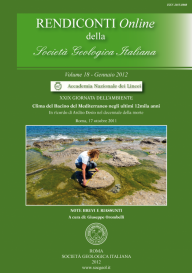
Oxygen isotope composition of continental carbonates as proxy for the reconstruction of the hydrological changes over the Mediterranean basin during the Holocene
Giovanni Zanchetta (*)
(*) Dipartimento di Scienze della Terra, Università di Pisa, Via S. Maria 53, 56126 Pisa. E-mail: zanchetta@dst.unipi.it
Volume: 18/2012
Pages: 39-41
Abstract
Since its beginning the stable isotope geochemistry supplied one of the most powerful tools for the reconstruction of paleoclimate. Starting from the late sixty oxygen isotope composition of carbonate precipitates (e.g. lacustrine marls, speleothems, tufa) was also used for the reconstruction of past hydrological conditions over the continents. In particular, isotopic records obtained from the Mediterranean region indicate that the Early - Middle Holocene was substantially characterised by wetter conditions. In details, some caves of Central Italy and Eastern Mediterranean indicate that the wettest phase was comprised between ca 9-7 ka. Oxygen isotopic record seems to indicate a second half of the Holocene characterised by drier conditions. Over this long term trend there is a more complex pattern of isotopic oscillations, which suggest the presence of climatic instabilities at millennia to centennial scale. Some of them seem to be common at the scale of the whole Mediterranean basin but the relatively low number of highly resolved, well dated, isotopic record do not allow detailed correlations.
Keywords
Get Full Text